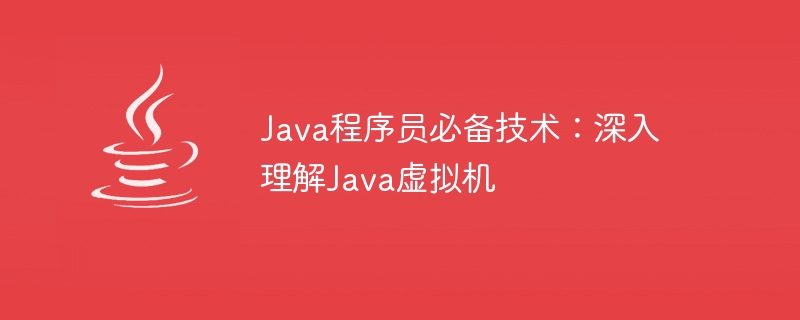Home >Java >javaTutorial >Essential skills: In-depth mastery of the Java virtual machine
Essential skills: In-depth mastery of the Java virtual machine
- WBOYWBOYWBOYWBOYWBOYWBOYWBOYWBOYWBOYWBOYWBOYWBOYWBOriginal
- 2024-01-13 14:52:13732browse

Essential skills for Java programmers: in-depth understanding of the Java virtual machine
Abstract: As a Java programmer, it is crucial to understand and in-depth understand the Java virtual machine. This article will introduce how to deeply understand the Java virtual machine, including the internal principles of the virtual machine, memory management, garbage collection mechanism, etc., and provide specific code examples to help readers better understand.
Introduction:
The Java Virtual Machine (JVM) is an important foundation for Java to achieve "write once, run anywhere". As Java programmers, understanding and in-depth understanding of the Java virtual machine can not only help us better understand the operating mechanism of Java, but also improve code performance and avoid some common problems.
- In-depth understanding of the meaning of Java virtual machine
Understanding the Java virtual machine is to better understand the running mechanism of Java programs. After compilation, the Java program will generate a bytecode file, and the bytecode file will be run on the Java virtual machine. Understanding the internal principles of the Java virtual machine helps us understand the execution process of bytecode, and can better optimize the code and solve some difficult to debug problems. - Learning about the internal principles of virtual machines
Understanding the internal principles of virtual machines is the first step to deeply understand the Java virtual machine. The interior of the virtual machine mainly includes class loading, bytecode interpretation and execution, method calling and memory management, etc. Among them, class loading is the process of loading bytecode files into the virtual machine and executing them, bytecode interpretation and execution is the process of the virtual machine executing the bytecodes, method calling is the process of the virtual machine calling methods, and memory management is Involves the virtual machine's management of memory areas such as heaps and stacks. - Learning of Memory Management Mechanism
During the running of Java programs, memory management is very important. Mastering the memory management mechanism of the Java virtual machine plays an important role in avoiding memory leaks and optimizing code performance. Memory management mainly includes the management of heap and stack, where the heap is used to store instances of objects, and the stack is used to store local variables and method calls. Understanding the virtual machine's memory management strategy can help us better tune the code and avoid some common problems. - Learning of Garbage Collection Mechanism
Garbage collection is an important feature of the Java virtual machine, which can help us automatically recycle useless objects and release memory resources. Understanding the garbage collection mechanism is of great significance for avoiding memory leaks and optimizing code performance. The garbage collection mechanism of the Java virtual machine is mainly based on the reachability analysis algorithm, which determines whether to recycle objects by judging whether they are reachable. Mastering the garbage collection mechanism can help us better understand the life cycle of objects and use memory resources rationally.
Code example:
The following is a simple code example that shows the memory management mechanism and garbage collection mechanism of the Java virtual machine:
public class MemoryExample {
public static void main(String[] args) {
Object obj1 = new Object(); // 在堆内存中分配一个新的对象
Object obj2 = obj1; // 将obj2指向obj1所指向的对象
obj1 = null; // 设定obj1为null,释放obj1对对象的引用
// 执行垃圾回收
System.gc();
if (obj2 != null) {
System.out.println("Object is still alive.");
} else {
System.out.println("Object has been garbage collected.");
}
}
}In the above code example , we create an object obj1, and then use another reference obj2 to point to obj1. Next, we set obj1 to null and release the reference to the object. Finally, we manually trigger garbage collection through System.gc(). If the object still exists, it means that the garbage collector has not recycled the object, otherwise it means that the object has been recycled by the garbage collector.
Conclusion:
In-depth understanding of the Java virtual machine is one of the necessary technologies for every Java programmer. By understanding the internal principles, memory management, and garbage collection mechanisms of virtual machines, we can better understand the running mechanism of the program, improve code performance, and avoid some common problems. This article provides specific code examples to help readers better understand the Java virtual machine.
The above is the detailed content of Essential skills: In-depth mastery of the Java virtual machine. For more information, please follow other related articles on the PHP Chinese website!

